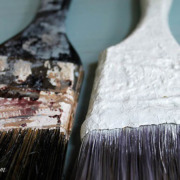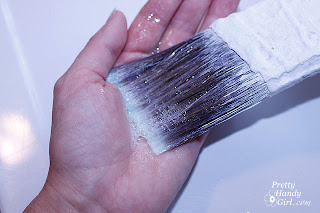Paintbrushes: The Good, The Bad, and How to Make them Behave
Today I have the skinny on paintbrushes, they all look alike, but they don’t behave alike! Pretty Handsome Guy and I have painted our fair share of rooms, especially dated brown trim moulding. One thing we learned early on is that buying a good brush was key to making a difficult job more manageable. When we first moved in and were cheap didn’t know any better, we bought the least expensive store brand brush we could find. What a mistake! Those brushes barely held up to one room of trim. The bristles frayed and the paint brushes lost their chisel shape.
Case in point:
But, if you spend a little more to buy a good quality brush and take good care of it, you can use that brush for years!!!
And a brand new never used Purdy brush.
Recently Purdy contacted me and asked if I wanted to try one of their brushes and maybe blog about it. I said sure, but I felt a little guilty. Why? (Whispering: Well, because we already have an arsenal of Purdy brushes in our painting supplies. When it comes to brushes, that is all we buy.) Okay, this is where I need to tell you that – yes, Purdy sent my a free brush and 5-in-1 painting tool to try out. But, did they pay me? No. And, did they ask me to write a positive review? No. So, I am being totally honest with you when I say that I do like their brushes. That being said, I have not tried some other high quality brushes. The only thing I do wish was different about Purdy brushes, is that they would develop an ergonomic handle for their brushes. After an hour of painting trim my hand always cramps up.
I haven’t bought any ergo handle type brushes, but I have seen this brush from Proform Technologies:
 |
| I might just have to try one of these next time. |
Okay, so I sold you on buying a good brush, and you were shocked by the price tag. Now I want to show how to care for that brush so it will behave for you (and you won’t have to replace it anytime soon.)
Be sure to clean your brush before the paint can dry on your brush. If you can’t wash it immediately, go ahead and leave your brush in a jar of water (or mineral spirits or turpentine for oil based stains or paint).
When you are ready, here is how to properly wash your paint brush:
Repeat on the opposite side.
and rinse any paint out of the inside of the brush.
Working in a circular motion, mix the soap in your hand with your brush
until a big lather forms.
I used large paper clips to make these hooks that hang over the sink.
If you are using an oil based paint you will want to substitute mineral spirits or turpentine for the soap and water. I also try to keep the brushes I use for oil paint or stains separate from my latex brushes.
Happy painting for years to come!














I know this is an old post, but someone may read this and want to know the same thing. I have found if you soak old brushes with dried paint in them in rubbing alcohol, you can get the paint out. After soaking, I use a toothbrush and soap (only going one direction, of course, toward the end of the bristles) to brush out the dried paint. I soak the brush for an hour or so, use a toothbrush on it getting out as much as you can, repeating the process soaking again if there is still dried paint on the brush, using fresh batch of rubbing alcohol. I always wash the brush with soap after this to get all the alcohol out of the brush.
Excellent information and very educational. I wrap my brushes with paper towels after cleaning to keep the bristles in place, but hanging them to dry is perfect when space permits. And using a good quality brush lessens the chance of leaving behind brush strokes. Thanks for sharing all your experience.
Can you stand one more suggestion on cleaning paint brushes? I attended a craft show and had some time to kill while waiting a demo on just that subject! The person doing the demo has written 2 books, one on wallpapering and one on painting. (Sorry, I don’t have his name or books any more but I learned a great trick from him…) He suggested Calgon Water Softener.. dilute it a little with water.just soak them in it for a while. Then use a small toothbrush or something similar…Paint almost floats off the brush. Squeeze it together at the tips when it is clean and (preferably) place it back in it’s cardboard sleeve. (If you don’t have the sleeve I wrap mine in a piece of paper and put a rubber band over the shank, not the bristles.) I have had one brush for over 30 years and it is still good! Thanks for sharing all your tips…your blog is interesting and I refer to it a ton! Hugs, Joy
Great tip Joy! Thanks for sharing.
I know this is an older post but I came upon it while doing a little research for our mudroom re-do…. I just wanted to share that after a long day of painting I do soak my brush in a cup of white vinegar to remove any dried paint residue and it works well to really get the top of the bristles cleaned. Also I keep a can of all those little tubes of hair conditioner (from dying my hair at home. Who does that?….) near my utility sink and after washing and rinsing the brushes I rub a little conditioner through the bristles and rinse them throughly and then squeeze them out and hang to dry. They are silky and smooth for the next use.
Awesome ideas! I love the conditioner idea ;-).
Loving your post on painting! I’ve painted many rooms after someone has done it poorly and it’s such a hassle to fix a botched job 🙁
One trick I use to make cleaning my brushes faster an easier is to use a plastic comb to remove the paint while rinsing/cleaning with solvent and again to remove water/solvent when they’re clean. Comb gently from the heel of the brush (where it meets the metal) to the tip. This removes the paint quickly and helps keep the bristles from getting roughed up (especially important with natural bristles). It also removes more paint from the heel, where a build up of dried paint can cause the “shaggy dog” problem and cause brushes to loose their shape. Winning Colours is a great product for removing latex paint from brushes (or floors, carpets, etc) and it’s earth friendly 🙂
Oh! & Try cutting the handle of your brushes shorter to make them easier on your hands and easier to use in tight spots!
Thank you SO much for writing this! I feel like so many people just throw their brushes away because they can’t clean them properly. Despite heavy painting around our 70’s panel-infested house, my cheapness has still kept me from buying the Purdy brush I so desperately need.
Do you have any suggestions for when the paint does dry on your brush during long stints of painting? Or is it best to just take a break and wash it every hour so that too much doesn’t accumulate?
Thanks for this post!
Love those Purdy brushes too. My tip. Use Murphy Oil Soap to clean out latex/acrylic paint. It is petro-based so the paint literally ‘melts’ out and the brush gets really clean. Rinse, take it outside and whip it down in a quick motion to remove the water. Then brush the bristles flat with a vegetable scrubber. Cut a piece of brown paper bag, fold a 2 inch piece down at the top of the paper at an angle for the Purdy angle brushes. Put the tip of the brush right into that crease then fold the sides over and secure with a rubber band around the metal (NOT the bristles) hang upside down like you showed, and your brush will be perfectly chiseled and ready to go. I’ve also used mine for years using this clean up method. P.S. I AM a professional painter that started out like you…..loving to see what paint can transform into a thing of beauty. I do a neat job, and have more requests than I can handle.